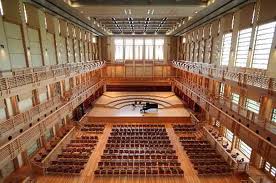|
Symphony
FROM THE NEW WORLD TO THE OLD WORLD
by Peter Lert
Saturday, June 14, 2025
Chamber
MC2 DUO RECITAL CLOSES 222'S SEASON
by Terry McNeill
Saturday, June 14, 2025
Choral and Vocal
CANTIAMO SONOMA'S LUSCIOUS A CAPELLA SINGING IN SEASON ENDING CONCERT
by Pamela Hicks Gailey
Sunday, June 8, 2025
Symphony
SRS SEASON ENDS WITH RESOUNDING TA-TA-TA-BANG
by Terry McNeill
Sunday, June 1, 2025
Symphony
YOUTHFUL VIRTUOSITY ON DISPLAY AT USO'S MAY CONCERTS
by Peter Lert
Saturday, May 17, 2025
Symphony
MYSTICAL PLANETS AND LIVELY GERSHWIN ORTIZ AT FINAL SRS CONCERT
by Peter Lert
Sunday, May 4, 2025
Symphony
VSO'S CONCERT MUSIC OF TIME, MUSIC OF PLACE
by Peter Lert
Sunday, April 27, 2025
VOCAL ELEGANCE AND FIRE AT THE 222'S RECITAL APRIL 26
by Pamela Hicks Gailey
Saturday, April 26, 2025
CANTIAMO SONOMA SINGS AN INSPIRED GOOD FRIDAY MOZART REQUIEM CONCERT
by Pamela Hicks Gailey
Friday, April 18, 2025
DRAMATIC SHOSTAKOVICH SYMPHONY CLOSES PHILHARMONIC'S 25TH SEASON
by Terry McNeill
Sunday, April 13, 2025
|
 |
 Weill Hall |
FULL MOON, FULL HOUSE
by Steve Osborn
Saturday, January 26, 2013
Under a full moon on Saturday, Jan. 26, before playing what he confidently predicted would be the first encore of the evening, cellist Yo Yo Ma paused to tell the overflow crowd at Weill Hall that they had “an unbelievable music room.” His choice of words is apt, because the magnificent space at the Green Music Center in Rohnert Park has both the grandeur of a symphony hall and the intimacy of a living room, at least from a sonic perspective. From the back of the hall, every note that Ma played throughout his two-hour recital was crystal clear, from the softest pianissimo to the mightiest triple fortes. You could close your eyes and believe he was only a few feet away, despite several dozen intervening rows of seats.
Ma and his able accompanist Kathryn Stott capitalized on this intimacy by shaping each note and phrase for maximum effect. The master cellist never seemed to play the same note twice, approaching each one as a unique entity, worthy of its own attention. This approach was nowhere more evident than in his mesmerizing rendition of Olivier Messiaen’s “Praise to the Eternity of Jesus,” in which his sustained and assured vibrato coaxed each long note into being and then let it fade away. A hush fell over the audience, which had just returned from intermission, as Ma proceeded through Messiaen’s serene but driven masterpiece.
Like many other selections in the recital, “Praise” was taken somewhat out of context so it would fit into Ma’s creative programming. The piece is actually the fifth movement of Messiaen’s eight-movement “Quartet for the End of Time.” Likewise, Manuel de Falla’s “Seven Spanish Folksongs,” which closed the first half of the show, were originally written for soprano, and the majestic Brahms sonata that concluded the evening was originally written for violin. No matter. Ma took them all and made them sound like each composer had really intended them for the cello.
As Ma hinted at the end of the show, one reason for all the transcriptions was to give the audience a whirlwind tour of the geography of classical music, beginning with the Russian Igor Stravinsky’s “Italian Suite,” followed by three pieces from South America, the seven Spanish songs, the French “Praise,” and the Austro-German sonata. For good measure, the encores were English (Elgar) and American (Gershwin).
The “Italian Suite”--which is yet another transcription, this time by the composer--got things rolling in a hurry. This collection of lively Baroque-inspired tunes is a virtuosic challenge for cellists, and even Ma had some intonation problems in some of the faster runs at the upper end of the fingerboard. These blemishes were trivial, however, compared to the immense musicality that Ma brought to the suite. The opening phrase was distinctly shaped, with a pregnant pause near the middle. Highlighting Stravinsky’s jagged rhythms, Ma moved his instrument around freely, with an almost casual grasp. The cello’s neck was often far to his left, and the body of the instrument well outside the normal range.
Pianist Stott was likewise far from her instrument. She played with outstretched arms and sat low on the bench. The positions of both players seemed to give them greater freedom, and their performance was a marvel of sudden stops and turns. The thrilling speed and intricacy of the next-to-last movement, a tarantella, was so compelling that the audience burst into indecorous applause.
After the manic energy of the opening suite, Ma calmed the atmosphere with the three pieces from South America, by Villa-Lobos (“Alma Brasileira”), Piazzolla (“Oblivion”) and Guarnieri (“Dansa Negra”). Of these the Piazzolla was the standout, allowing Ma to generate room-filling sound from his lower strings. His cello really began to sing during the piece, which culminates with an unforgettable downward glissando.
Several of the de Falla songs were instantly recognizable Spanish folk tunes, with characteristic Flamenco rhythms and passionate melodies. Each shone in its own way, but the final one, “Polo,” offered a particularly wonderful opportunity for Ma to display his relentless drive. His energy seemed barely contained, almost on the verge of explosion, yet he somehow managed to channel all of it into his fingers and hands.
Intermission brought a chance to stroll into the courtyard and bask under the full moon, which sat above the concert hall as if granting benediction. The sight was a perfect appetizer for the heavenly Messiaen that began the second half. Following that transcendent performance was not easy, but Ma slid into the subsequent Brahms sonata as if into a pair of well-worn slippers. Despite the transcription from violin to cello, everything fit perfectly. The assurance was complete, the story compelling, the sound gorgeous. Toward the end of the last movement, Ma stood up briefly, as if to gather strength for the final plunge and the encores to follow.
|
